|
return
to homepage
return
to updates
Currin
Again
by
Miles Mathis
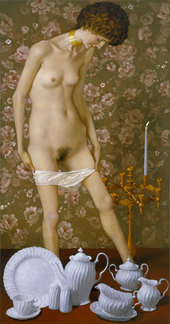
go
to first Currin article from 2004.
go
to second Currin article from 2004.
I am but mad
north by northwest:
when the wind is southerly, I know
a
hawk from a handsaw.—Shakespeare
February
13, 2008
In this latest winter of our
discontent, the desperation of the New York avant garde is
reaching new and perhaps final levels of gassiness. Realizing
that they once again, for the 92nd year in row, have
nothing to write about or look at worth writing about or looking
at, they return, as if by rote, to John Currin, their last best,
though pathetically shallow, hope. One can only hope, with pathos
and bathos, it is their last.
Now, Currin himself admitted going
into a funk—or what he called a “dry spell”—in 2004,
after his success at the Whitney and all his big-city write-ups.
It wasn’t very good timing for a dry spell, since Gagosian had
just taken him away from Andrea Rosen and raised his prices into
the exosphere. Two years later, in 2006, Currin had a small show
at Gagosian which did not even come close to selling out. Many of
the paintings are still listed at the Gagosian website. Beyond
that, none of his works since 2003 are nearly as interesting—even
as illustration—as his earlier things like Hobo and
Sno-bo. He has developed a heightened interest in
technique, as we shall see, and his technique has gotten a bit
better in the meantime. But it appears that he has long since
emptied his narrow quiver.
Not to worry, the avant garde has
never needed actual artworks to go on. It subsists entirely on
the write-ups and always has, and if breasts are sagging or
members are flagging, they just spill more ink in more high-tone
places. Hence we find another long pointless paean in the New
Yorker , to follow similar things in GQ and Penthouse
and lord knows where else. A small, sad show in London is the
proffered occasion this time, but that is just an excuse for
another blubbering tour through the fashionable townhouse and a
rehash of the resume.
The readers and writers of
contemporary magazines—these Leviathans of taste and
culture—don’t know art from garfunkel, but they hunger for
pictures of the artist and his family and his bed and his studio
and his wine cellar and his bookshelf and his palm pilot and his
tie collection. And they thirst for gossip about his past and his
future and his prices and his dog and his childhood sweethearts
and his suits. To them it matters not what Currin has or has not
painted, it only matters who he has married and what parties he
goes to and whether he is the 19th best dressed man on
the East Coast or the 20th, and how tall he is.
I would have been too shagged out
from chronic malaise to comment on this, except that Currin says
a couple of exceedingly stupid things here, even stupider than
usual (even stupider than the avant garde artist is usually paid
to say) and this put me in the mood to write.
As it turns out, Currin is now so
desperate for relevance that he is trying to tie his recent
pornographic output to world politics. Let me lead by saying I
don’t care that he is painting porn. It doesn’t offend me; it
doesn’t impress me. I look at nudity and sex on the internet
and sometimes enjoy it. The difference is I would never try to
defend my art, or apologize for my sex-gazing, by tying it to
politics of any kind. But for some reason Currin finds this
necessary. He says,
I know how right wing this sounds .
. . but I was thinking how pornography could be a superstitious
offering to the gods of a dying race.
No, John, that doesn’t sound
right wing, it just sounds phony. It is the among the
worst-disguised fake philosophy of the last decade (and has a lot
of competition in that regard). And it doesn’t even make sense.
As far as this “dying race” is the race of people with white
European ancestry (this must be what he means, in context), the
gods of this race would not and could not be propitiated by such
an offering. If this race is dying then it is dying because its
gods are Mammon and Moloch, not Isis or Aphrodite or Freyja. Our
gods are not big-dicked totems or cow-uddered rock carvings and
haven’t been for millennia. Those gods are buried deep in the
earth and you couldn’t raise them by a century of sex or a pile
of porn to the moon.
Currin can’t really think he is
being superstitious or religious, but even if he did he would be
very confused. A chrome and enamel flat in Soho is not the first
place one would think to go to build a pagan altar to the earthy
gods. If Currin is trying to score points in some heaven, his
checks from Sadie Coles and Gagosian and his deification by
Robert Rosenblum and Peter Schjeldahl are not going to be
outweighed on the scales by a million hecatombs of burning oxen
or by a billion beddings of Erato.
And they especially are not going
to be outweighed by such tepid and ugly images as the new porn
series. Sno-bo was a thousand times sexier than these new
copulation shots (and even she is not going to score high with
the Muses—as I have it from them directly). Of all the porn to
pick, why this?
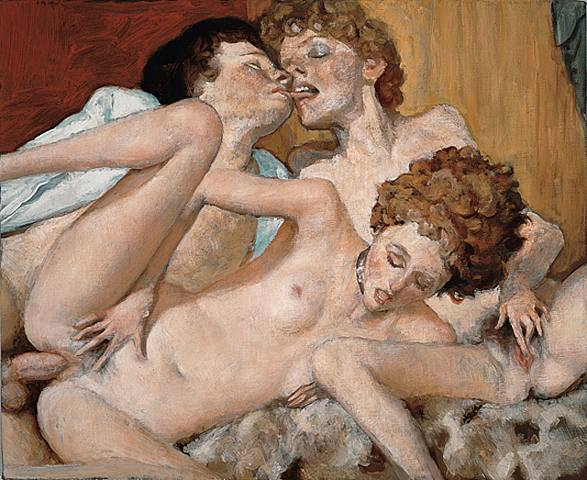
Currin tells us he painted this
because of the twelve Danish newspaper cartoons of the Prophet
Muhammad and “the killing of Theo van Gogh, the film director,
by some jihadist in Amsterdam—all of a sudden the most liberal
societies in the world were having intimidation murders happen.
That's when it occured to me that we might lose this thing—not
the Iraq war but the larger struggle.”
As if that weren’t enough and
more than enough, he continued,
I'm gonna have a fucking fatwa on
me for saying this, but I had a kind of cockamamy political idea
that this is what we're fighting the Islamists with: They've got
the Koran, and we've got the best porn ever made! I mean that as
a joke but also as something that's literally true. . . .In the
European theater the question seemed to be, “Who's going to
win? Allah or porn?” Personally, I hope we win. I hope porn
wins.
Didn’t Currin have some sort of
veto clause in this interview? Some sort of emergency small-print
that allowed him a late self-edit just in case he started quoting
Rush Limbaugh or started channeling Danny Bonaduce from the
Partridge Family, Season 2? I mean, good god, what
is this about a “European theater”? Does he mean the cineplex
in Hamburg, or is he leaning over a map in his basement, moving
around toy soldiers and Sherman tanks?
Just to be clear, these quotes
don’t sound either left or right to me. They sound like Currin
has been scouted by the CIA, and the CIA is (officially)
non-partisan. Currin lives in NYC and has eyes and ears. Almost
seven years after 911, he can’t really believe that the Muslims
are the enemy in any real “theater”, or that Islam is the
primary threat to world peace. No, his “dying race” is that
threat, and everyone knows it, or should. Outside the US, this
knowledge is nearly unanimous. I just lived in Belgium for three
years, and I can tell you that white Europeans, even the ones who
want the Muslims to live somewhere else, don’t think any nation
of Islam is the primary aggressor in the world. The Dutch and
Flemish nationalists may want uni-culturalism above all else, but
unless they are also with covert operations—like Theo van Gogh
was (is)—they aren’t denying that the US is the empire on the
move. Europeans have their own sort of blindered and blinkered
view: they no longer see themselves as the problem—since we in
the US have taken on that mantle. In their eyes, they are not the
dying race, we are. Like the Native Americans, the
Europeans are waiting for us to commit cultural suicide, so that
they can pick up the pieces. We may be the great great
grandchildren to these Europeans, but we left the house long ago.
We aren’t their concern anymore. They can deny the blood link,
if it comes down to it. In their opinion, we are committing
cultural suicide by spreading empire too far, too fast, and with
no finesse. They know that in the tally of “intimidation
murders” we have no competitors, in this century or any other.
We left the Huns and the Romans behind us decades ago. Even the
Germans look at us like a newly minted race, capable of things
even they never thought of.
But it should not be necessary to
live abroad to have some inkling of this. I hear that the
internet may now be available in Manhattan. Currin is sold as
avant, cutting edge, smart-as-a-whip, Yale-educated, Jewish
married, and so on; but he still gets his news straight from the
White House or Rupert Murdoch, apparently. This doesn’t make
him rightist, necessarily; it makes him either an idiot or a
plant.
We will assume he is not an idiot.
We will assume that he is using words like “cockamamy” only
to seem like a friendly rube, appealing to the common man that
reads the New Yorker. But that begs the question if he is
getting his politics from his in-laws. All this talk of Theo van
Gogh and Islamic jihadists and so on sounds an awful lot like
Alan Dershowitz. I don’t think Dershowitz has ever pulled porn
into the mix like this, but otherwise the similarities are
striking. The hawks, Jewish and non-Jewish, always find a way to
focus on the one guy in Holland instead of the thousands or
millions with our mark on them.
Like his handlers—whoever they
are—John has to pretend to be more concerned with one or two
“intimidation murders” in “liberal societies” than he is
with millions of murders in Iraq and around the world. For him,
the question is not Iraq, it is the “larger struggle” of porn
against Allah.
This can only be seen as a perverse
new twist in the globalist bi-partisan Jewish/Christian/Atheist
propaganda machine to sell pre-emptive and continuous war as “a
guarantee of freedom.” We are not murdering innocent men,
women, and children just for oil, we are doing it for porn.
Well, John, that really sells it
for me, boy. I had thought we were doing it for some selfish
reasons—so that we could continue to drive our Hummers, for
instance, and talk on our cellphones and drink bottled water. But
no, it is so that we can continue to masturbate with full rights
and a clean conscience. The fertility gods must smile upon such
actions. What do they care if hundreds of thousands of foreigners
conceived in sex are starved and killed in forests of famine and
lakes of blood, as long as we follow it by a Soho sacrifice to
Frigg? One or two shitty paintings should buy us a quick
indulgence, a guarantee of a touchdown or two, and a convincing
win in the war for “democracy.”
Do I expect anyone else will call
him on this, especially from the so-called left? Not a chance. In
the “American theater”, there is no left, at least not in the
art scene or in the journals. The progressivism of the avant
garde is just a pose, a marketing ploy. When it gets right down
to it, these people have all the creative courage of a Hallmark
Card or a member of Congress.
In championing any kind of freedom,
even the freedom to masturbate, Currin will be hailed as a hero
of the left. Worldwide mass murders don’t register with these
people. Republican and Democrat, Jew and Gentile, they hold hands
and sing God Bless America while robbing the poor box to buy more
bombs. Even 3000 of their own murdered, in their own home town,
by their own government, can be ignored as inconsequential next
to the freedom to masturbate and make false offerings to silly
gods. Some radical feminist at the Village Voice can
attack Currin for painting big tits, that is, but don’t expect
anyone to attack him for parroting CIA handbills or for sounding
like a commercial for the Department of Defense. The
Pentagon-Porn alliance: “Fighting Terrorists, one Fuck at a
Time!”
But let’s switch gears and
actually look at the paintings. I know this will shock the avant
garde: actually having to look at the images without a pre-set
screen, a playbook, or a list of platitudes. But it occurs to me
it might be helpful.
Here is what Currin says about
them:
I’ve always felt insecure about
being a figurative artist, and about being an American painter.
My technique is in no way comparable to that of a mid-level
European painter of the 19th century. They had way
more ability and technical assurance.
As I pointed out several years ago,
in each interview Currin always passes through a tiny window of
clarity and says at least one thing that is true. In this
interview, this is it. We would be tempted to give him some
credit for humility or insight, except that we remember him
saying in those other interviews that he wanted to be famous and
to get lots of attention. In this one we are told he is right
where he wants to be, so it is difficult to work up much empathy
for him. We could take this quote as some sort of admission of
bad faith, but it makes more sense to take it like [the British
portrait painter] Stuart
Pearson Wright’s admission that the avant garde is right
about a lot of things. Especially as regards that first sentence:
the avant garde expects
figurative painters to be insecure, and Currin is good enough to
oblige them. They have spent half of every year’s budget for 80
years being sure that figurative painters were insecure, or
worse, and Currin would never have been allowed into the game if
he didn’t play along. Even if he weren’t
insecure, there is likely a clause in his contract that requires
him to say he is at
least five times a year.
Jed Perl at the New Republic has
been even harder on Currin than Currin pretends to be on himself.
He calls Currin’s paintings,
Mousy imitations of old master
portrait styles that would not earn him a freelance gig as a
magazine illustrator.
Strong, but too strong. This is
precisely where Currin should be, supposing he could find a
magazine that needed nearly nude cartoons in the snow. Currin has
an illustrator’s style as well as an illustrator’s mind and
level of creativity. He cannot give a face any real depth or
life, but he can certainly produce figures that are interesting
in their own limited ways. You wouldn’t want to look at Sno-bo
everyday: she would wear pretty thin, so to speak. But you don’t
mind looking once or twice. She’s cute and clever, and it would
be pointless to deny it. Is she a damn good illustration? Yes. Is
she worth a million dollars? No.
To show why I think this is
so, in even greater detail, let us look at what has been called
his best recent painting, by critics and non-critics alike. A
portrait of his son.
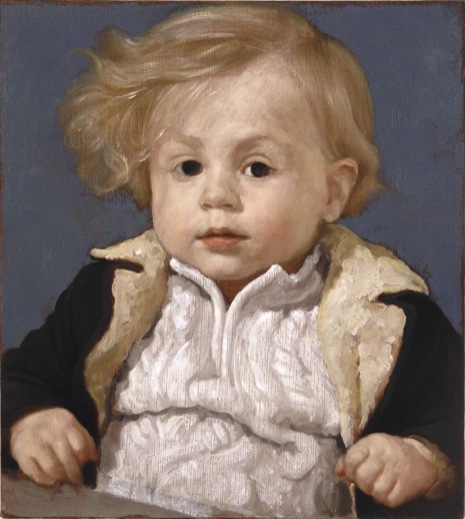
I agree that this is one of his
best works. It has a certain charm. It is not phony in any way.
It is the kind of straightforward painting we wish he were
allowed to do, and would do. But of course if he did this sort of
thing all the time, he wouldn’t be where he is. He would be
where I am.
And if he were where I am, then
people would have to look a bit harder at this work. Compared to
his other work, it is a gem. Compared to any good portrait, it is
a failure. Why? You may think it is due to some technical
problem. This is how the other portrait painters would critique
it; and the painting does have problems technically, as I will
show in a minute. But that is not why I think it fails. It fails
because the little boy is not alive. The eyes are dead. Remember
how Michael Kimmelman put it in his New York Times review
in 2003: “Eyes in Mr. Currin's work tend to be black holes,
sucking up light." Back then this was considered a bit of
flattery. The avant garde wants people looking like
mannequins, since this plays into their critique of society. But
Currin has not found it easy to turn off his “critical
distance” or his sangfroid or whatever it is. He has created no
connection here to his own son. The boy looks like a pretty doll.
Currin is finally beginning to
learn some of the technical tricks of the old masters, but he
still hasn’t learned the cardinal rule of traditional painting:
you have to make the face live. He should have studied Van
Dyck or Titian instead of Velasquez’ s Infantas. Velasquez
painted the princesses as little dolls, just like this, and that
is why no one likes them as much as his portraits of the dwarfs
or his other friends at court. Currin has an unerring instinct
for the lifeless and mannered, so that even when he goes to
Velasquez—the right teacher, in many ways—he still ends up
with an emotional nullity.
The eyes are the main problem,
since they have no life or sparkle. Part of this is strictly
technical. The eyeballs need to curve and the irises need touch
lights and color variation and so on. But it is more than that,
since the mouth also has no expression. You could add a lot of
technical tricks to liven up the paint of the mouth, but
it would still have no expression because Currin photographed the
boy when he was not expressing anything. The boy is very pretty,
and nattily dressed, but the mood of the piece is flat.
Currin also doesn’t know what he
is doing with his light. He doesn’t have enough tonal variation
in the skin to create a real curvature, and this is because he is
lighting from the wrong angle. He has only two basic tones in his
skin. He has no real highlights and no real shadows. This is what
flattens out the face and makes it look like an illustration.
Then look at what he does with the
background. He has chosen a good color, but he doesn’t appear
to know what to do when it meets the figure. He just takes it up
to the edge of the figure and lets it stop. It looks like a
pastel sketch or something. This is why the little boy looks
pasted onto the canvas. He doesn’t really live in that
background, it just hangs around him, flatly.
Currin has this problem with all
his edges here. It is because they didn’t teach him anything at
Yale and he is having to re-invent the wheel. He is scared to go
wet into wet, but you have to overlap and repaint to get these
edges to blend.
To be fair, he has also done a lot
of things right here. His color harmony is lovely. He hasn’t
felt a need to over-saturate, as so many realists now do. His
drawing is very good. The hair has a nice degree of finish, not
too much not too little. And he has picked a fetching costume.
All these things take real talent, and Currin is not without
talent. But because, up to now, he has been more interested in
getting rich and famous than in learning how to paint, he has
what he would be expected to have: a big bank account and an
unimpressive oeuvre.
Just to put to rest all these
claims of mastery and direct comparisons to the greats, let's
look at a close-up of one of his better-known
paintings.
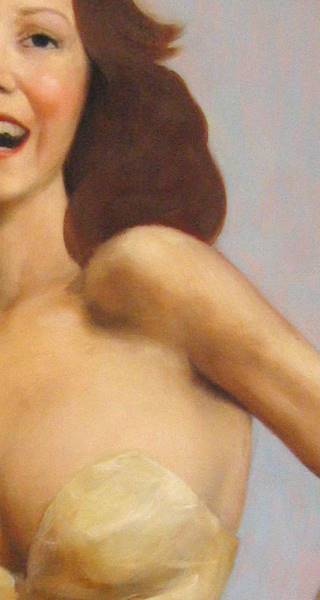
There
is nothing wrong with that as a piece of illustration, but don't
tell me it compares to Caravaggio or Sargent. Ignoring subject
matter and just looking at paint quality, anyone who has ever
held a brush will tell you Currin has only a tithe of the depth
or complexity of even the worst of the real painters of history.
Currin admits it himself, above. And this illustrative technique
was chosen on purpose. It is not a failing. If he really
achieved the complexity and depth of the Old Masters, he would be
thrown out of the avant garde as a dangerous virus. They can't
have that. They allow this mocking downgrade of realism in order
to undercut realism. Currin's technique is not an homage or a
return to mastery, it is intentional propaganda against
mastery. This is its use to the avant garde. Surely Currin
understands that.
Let’s return for a moment to Sno-bo.
Notice that I do Currin the favor of looking at his best work. It
is a work that is very popular and it is a work that I like.
Arthur Danto of The Nation says this of Hobo and
Sno-bo:
The two figures are exceedingly
mysterious. . . .As paintings they have the power to hold us in
front of them, contemplating meanings too fragile and remote for
application to life.
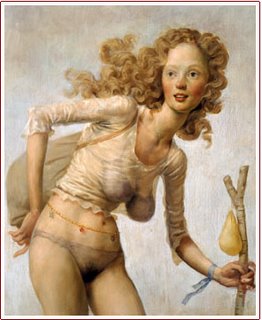 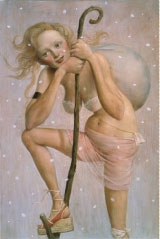
Come
on! “Exceedingly mysterious”? “Meanings too fragile and
remote”? I like the paintings, but I don’t see any mystery or
anything remote there. They’re clever cartoons, made specially
for guys who like their women skinny and blonde. I do, but I
can’t pretend there is anything mysterious about it,
particularly when I am looking at these cartoons. I thought that
was the whole point of them. Not to mystify, but to de-mystify.
Danto doesn’t even know how to look at an image, much less take
the artist at his word. If Currin had been trying consciously or
unconsciously to plumb some depths of sex or desire, do you think
he would have chosen this subject to paint, or given it such a
perfectly inane title? Currin is no doubt satisfied to allow such
misreadings, since they make the painting bigger and more
expensive than it is. But they remain egregious misreadings.
As another example of Danto’s
complete missing of every point, lets look at another quote:
One cannot become a Mannerist as a
matter of stylistic decision. One has to allow talents to show
that have been held in check all along.
Just the opposite of the truth, as
usual. If he would only ask Currin, I am sure Currin would tell
him that the mannerist style that he borrowed was borrowed as a
“stylistic decision,” with full premeditation. In fact, this
used to be the understanding about Currin’s style. It was good
precisely because it was premeditated, and therefore false. If it
had been genuine, if it had been arrived at in any natural way,
it would not have been accepted by the avant garde, by places
like the Whitney and the Guggenheim and MoMA. The Whitney has it
in writing somewhere, I think, that no earnestness in style will
be tolerated. If you are not a tongue-in-cheek realist, you are a
real realist, in which case you are a danger, a pariah, and a
potential terrorist.
In fact, Currin is on very
dangerous ground with this portrait of his son, and I think he
knows it. That is precisely why he was careful to surround it
with large canvases of porn and other ironic swagger in his show.
The avant garde may forgive him for one or two portraits of his
son, as a sample of aberrant behavior or a temporary sign of
madness. But he best not make a habit of it.
Odd Nerdrum is in precisely the
same boat, a boat floating three feet above the water—so that
no paddle may reach it. One of Nerdrum’s best-loved paintings
is the one of his daughter Amo.
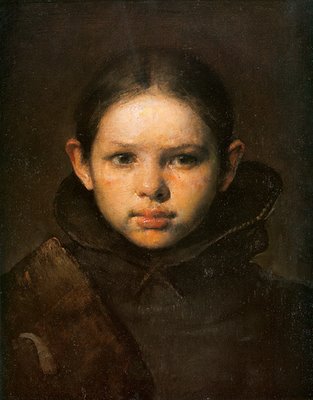
The
child in this painting is fully alive, full of emotion, and
painted with complete technical knowledge and assurance. But
Nerdrum is in the same boat as Currin, since he cannot paint this
sort of thing everyday. It is allowed only once in a blue moon.
It must be surrounded by hooded freaks flexing their feet and
chanting at the moon. If Nerdrum painted all his subjects in a
straightforward manner, without manufactured mythologies and
premeditated weirdnesses, he would still be struggling in
obscurity, fenced out of the upper echelon of contemporary art
which is Pluralism. Amo wasn’t Nerdrum’s entrée into
the big time, it was paintings of one-armed hermaphrodites and
nudes dumping in the woods.
Let me simplify this for you even
more. Why is Currin in a higher price range? you may ask. 1)
Nerdrum is better technically: but that doesn’t matter, since
almost no one can see that. These major critics have compared
Currin to everyone from Parmigianino to Sargent, so it is clear
they are just dropping names. For them, any realist head is
pretty much equivalent to any other: the hierarchy from Alex Katz
to Titian is invisible to them, even as a sheer matter of
technique. 2) Currin and Nerdrum both paint weird things, so in
that regard we have a tie. In the avant garde, you are either in
or you are out, and they are weird enough to be in. The
hierarchies once you are in don’t have anything to do with the
actual art. You can have a brick on the floor or a 20-foot canvas
with six perfectly painted figures. The latter will not score you
any extra points, and it may actually harm you. But Currin and
Nerdrum are similar enough in the eyes of the avant garde that we
have no separation here. 3) The whole reason Nerdrum is not as
famous or expensive as Currin is that Nerdrum is in Iceland, not
New York City; he is not married to the daughter of a Jewish
dermatologist who he found in a faux gingerbread house in a
gallery in Soho; and he doesn’t go to parties with Mick Jagger
and Marc Jacobs and Chloe Sevigny, wearing two thousand dollar
suits. Nerdrum is still so naïve and un-American that he
actually spends his time painting. He should quit jacking off and
come sleep with Larry Gagosian or Mary Boone or someone.
As a closer, I want to look at one
more quote of Currin from this interview in the New Yorker:
The way things are painted trumps
everything else.
This is given us as a reward at the
very end of the article, as if it is very deep. But not only is
it not deep, it is not true. Ironically, it does push Currin in
line with Sargent, at least for a moment. Eleanor Heartney in Art
in America has claimed that Currin’s style has something in
common with Sargent’s style, but that is absurd. Currin has
nothing in common with Sargent but this quote. When Sargent was
at Broadway, Worchestershire, about the time he was painting
Carnation, Lily, Lily, Rose, he said something very much
like this. He said that it wasn’t so much what you painted as
how you painted it, and he attempted to prove it by setting up
his easel in a field at random and painting whatever was in front
of him. It didn’t last for long, of course, since that was all
balderdash. Carnation, Lily, Lily, Rose is one of the most
manufactured things ever painted. It took months of model time
for the two girls, frozen in place every day at the same time, 15
minutes before sunset. This is how real paintings are made. They
aren’t accidents. And they aren’t paint samples, either. The
way things are painted doesn’t matter at all, unless they are
painted poorly. The subject and the treatment of the subject are
what matter.
There are dozens of perfectly good
and serviceable styles and methods in the history of figure
painting. Some are tight, some loose, some outlined, some
blended, some alla prima, some layered, some with high color,
some with little color. None of these methods is necessarily
superior to any other. As far as they are permanent, and express
what needed to be expressed, they are artistically equivalent.
The perfect example of this is
Currin himself. Currin’s technique is not perfect, but Currin’s
main problem is not his technique. Currin’s main problem is his
subject matter. Most of the time he is piecing together weird
stuff he has found, in order to impress some critic or jury.
Except when he is painting his son, he is not painting anything
meaningful to him. Even his wife is used as a cut-out to be
pushed in some way. He is always using her to make some clever
statement or composition; he is never just painting her. I
haven’t seen a straightforward portrait of her, (although I
would like to). The closest he has come is Rachel in Fur.
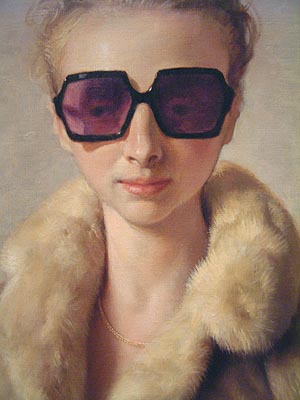
But
she is wearing those stupid purple sunglasses. Even here he is
pushing his subject to appeal to modern standards and
requirements. It is as if he can’t turn off the self-conscious
games and asides for a moment. It isn’t enough for him—because
it isn’t enough for the avant garde—to just paint a face
because he loves it. Such a reason has no social relevance. What
can a critic say about a thing like that? What hook can a dealer
use to sell it?
If
this paper was useful to you in any way, please consider donating
a dollar (or more) to the SAVE THE ARTISTS FOUNDATION. This will
allow me to continue writing these "unpublishable"
things. Don't be confused by paying Melisa Smith--that is just
one of my many noms de plume. If you are a Paypal user,
there is no fee; so it might be worth your while to become one.
Otherwise they will rob us 33 cents for each transaction.
|